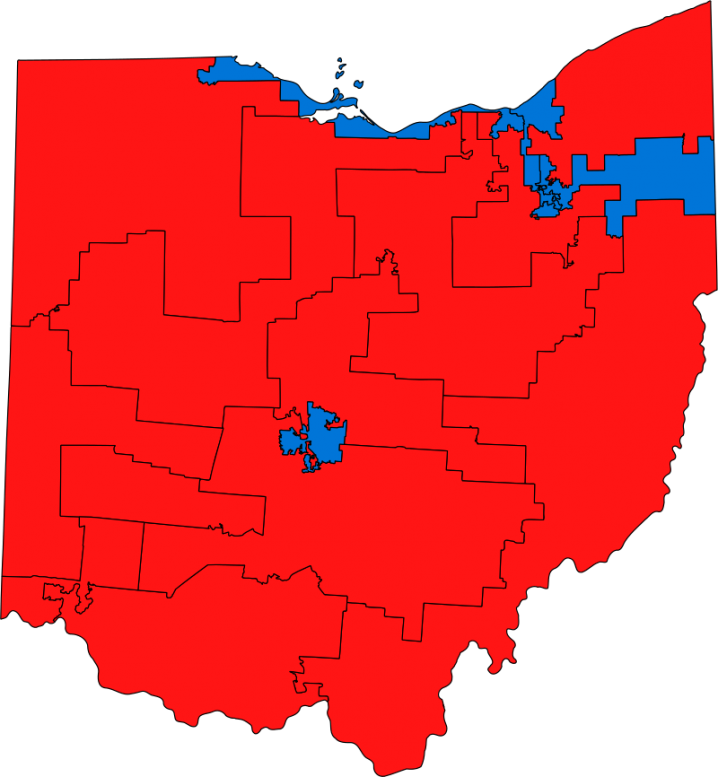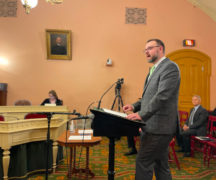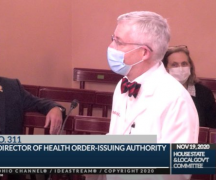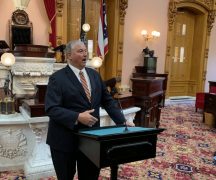Gov. Mike DeWine and Lt. Gov. Jon Husted on Tuesday said they hope a new system of drawing congressional and state legislative districts will result in more competitive elections. But, they cautioned, the task will be far from simple.
Ohio has among the worst partisan gerrymandering, according to multiple analyses.
Districts are typically redrawn once every 10 years to reflect population changes when new census data become available. Until now, the party in control of the Statehouse has commanded the process and, using modern technology, that party has been able to greatly advantage itself.
A 2019 analysis by the Associated Press determined that in the U.S. House, Ohio Republicans got 52% of the vote but held 75% of the seats. They also held supermajorities in the state House and Senate that exceeded the portion of votes they received at the polls, the analysis found.
A separate 2013 analysis found that Ohio Democrats were the second-most underrepresented in the U.S. House and that Republicans were overrepresented by 18 seats nationwide. The imbalance was a consequence of the fact that the GOP wiped out Democrats in statehouse races in 2010 and had control of the last redistricting process in most states.
The problems created by such a partisan skew extend beyond unbalanced party representation. It also fuels polarization and extremism.
“We’ve all read the same studies about how many of the 435 congressional districts in the country aren’t really competitive and for many of them, the greatest… perceived threat to the incumbent is a primary,” DeWine said.
Voter turnout in party primaries tends to be much lower than in general elections and is dominated by the most ardent partisans — a dynamic that can result in winning candidates with fringe views that would make them sure losers in a competitive general election.
Think Rep. Marjorie Taylor Greene, R-Ga., who has a record of expressing racist views, denying the reality of school shootings and whose speculations that California wildfires might have nefarious origins resulted in the mocking hashtag #JewishSpaceLasers.
He’s a member of her party, but comments by Senate Majority Leader Mitch McConnell, R-Ky., on Monday might indicate that even when they add to GOP numbers, highly gerrymandered districts are damaging to his party. He didn’t mention Greene by name, but his reference was clear when he said many of the “loony lies” expressed by her were “a cancer for the Republican Party.”
Closer to home, Rep. Jim Jordan, R-Ohio, endorsed Greene in her bid last year to win a crowded Republican Primary so she could run unopposed in the General Election.
Jordan himself has espoused conspiracy theories — including speaking at one of President Donald Trump’s “Stop the Steal” rallies on Nov. 5.
Lies by fringe politicians about a stolen election pose an even more direct threat to American democracy. They fueled a Jan. 6 insurrection at the U.S. Capitol that killed five and delayed certification of the presidential election.
One of Trump’s closest allies, Jordan was reelected to his District 4 seat with nearly 70% of the vote.
There was widespread speculation that Jordan might seek the GOP nomination to fill the U.S. Senate seat held by Rob Portman, a Republican who is stepping down in 2022. Jordan later announced that he would not seek the seat.
His office didn’t respond Tuesday when asked if the congressman had calculated that he couldn’t win outside of his gerrymandered district.
DeWine wasn’t asked about Jordan, but of the scarcity of competitive congressional races he said, “Truly, it is a national problem.”
To address the issue, Ohio voters in 2018 overwhelmingly approved a system that would require bipartisan support for 10-year congressional maps. If that fails, four-year districts could be drawn with a party-line vote.
Husted, the lieutenant governor, said the new system has multiple goals, some of which may be mutually complicating.
In Ohio and elsewhere, the crazy shape of districts such as Jordan’s have been widely criticized. His zigs and zags and goes from just west of Columbus almost to the Indiana line, north almost to Toledo and east almost to Cleveland.
Techniques known as “cracking and packing” have been used to draw districts that maximize partisan numbers. But they often result in maps that don’t make much sense when it comes to representing constituent interests.
The new system is “designed to hit the goals of making the districts more compact, less gerrymandered, keeping communities of interest together,” Husted said. “We think those are positive enhancements to the system and it will ultimately lead to representation that is more consistent among those communities.”
But doing that while also drawing competitive districts has become more difficult as politics have become more polarized — especially along geographic lines, DeWine said.
“The counties that were Republican 10 years ago may be much more Republican today,” he said. “In other words, the margins have gone way up and we’ve seen the same thing with Democrat counties.”
***
Advocates, legislators want more from governor’s education budget
With no changes planned for the state education funding formula included in Gov. Mike DeWine’s proposed budget, education advocates and some state legislators are left wanting more.
“The devil is always in the details,” said Scott DiMauro, head of the Ohio Education Association, in a statement after the release of the budget. “Education spending must be a top priority in Ohio to ensure our students, educators and communities receive the resources they need to succeed.”
DeWine’s budget proposal brings funding back to pre-pandemic levels and includes a jump in non-academic wraparound services, but saves the bulk of changes to education funding for the legislature to figure out.
The OEA said they were encouraged by an expansion to broadband access and mental health services as part of the support for schools.
“However, OEA is disheartened to see the same amount of general revenue fund money is going into the state’s foundation formula as in (fiscal year) 18,” the association wrote in their statement. READ MORE
DeWine seeks more state spending for public health causes in Ohio
Gov. Mike DeWine wants to see the state of Ohio invest more in public health initiatives over the coming years to impact the COVID-19 pandemic response and numerous other health needs.
DeWine rolled out his administration’s biennial budget proposal on Monday, which includes suggested funding amounts for all state agencies for the fiscal years 2022 and 2023. (You can read an overview of the budget proposal here.)
The governor’s budget proposes an increase in state spending toward the Ohio Department of Health, with investments in data reporting improvements, addiction services, pregnancy support and addressing social inequities of healthcare access.
Some of this money would benefit city and county health departments, which are mostly supported by local levies.
“One of the long term goals of our administration is to build up our local health departments,” DeWine said at a Tuesday news conference. “We’ve ignored public health in this country for too long. And if this pandemic has taught us anything, it’s that we can no longer afford to underfund public health.” READ MORE
Despite anti-vaccine protest, teacher immunizations off to smooth start
HILLIARD — Ohio teachers began their march toward immunity Wednesday, despite a small crowd of anti-vaccine activists who protested outside the first COVID-19 vaccine clinic for Ohio educators.
Even before the first appointments at noon, teachers lined up outside Hilliard Davidson High School for appointments to receive a vaccine against the new coronavirus.
Gov. Mike DeWine opted to prioritize immunizing teachers, along with the ill and the elderly, as a means to speed up the reopening of schools.
On the sidewalk just off campus, meanwhile, about 15 anti-vaccine activists stood in the February cold to hold a large sign and distribute a flier of anti-vaccine propaganda, stoking baseless fears of vaccine injury.
The key step toward immunity Wednesday (which still requires a few weeks’ time and booster shot) came as relief for teachers, many of whom have led in-person classes despite a pandemic that has infected more than 900,000 Ohioans and killed more than 11,000 of them since March.
“I feel like we made history,” said Jessica Kocak, a high school algebra teacher from Upper Arlington. READ MORE





